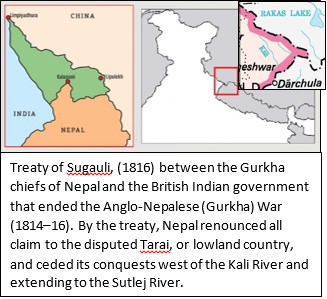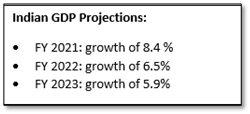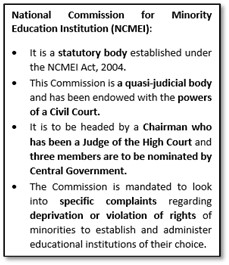Tuesday, 18th January 2022
Oxfam report: ‘Inequality Kills’
In News
On the first day of the World Economic Forum's online Davos Agenda summit, Oxfam International released its report titled 'Inequality Kills'.
Major Findings of the Report
- Deepening Divide: Since the pandemic began a new billionaire has been created every 26 hours, and the world’s 10 richest men have doubled their fortunes, while over 160 million people are projected to have been pushed into poverty.
- Rise in Inequality: According to the projections of many institutions, the pandemic has triggered a spike in inequality within countries across the world.
- Factors of Inequality: Inequality between countries is manifested in the likelihood of covid related deaths. This inequality may be linked to historical legacies of racism, including slavery and colonialism.
- People of Bangladeshi origin were five times more likely to die of COVID-19 compared with the White British population in England during the second wave of the pandemic.
- Gender Divide: Gender inequality within countries has risen with a consequent rise in gender-based violence. The goal of achieving gender parity has been set back to 135 years from the previous 99 years. Women have absorbed the shock of unpaid care work that keeps them trapped at the bottom of the global economy during the pandemic.
- Vaccine Monopoly: Instead of becoming a global public good, the covid vaccines has led to increase in the wealth of pharmaceutical companies, who now monopolise the market and indirectly decide who gets the vaccine and who do not through price determination and IPR rules.
- Economic Violence: Extreme inequality is a form of “economic violence”—where structural and systemic policy and political choices that are skewed in favor of the richest and most powerful people result in direct harm to the vast majority of ordinary people worldwide. Inequality in healthcare access, gender based violence, hunger in a world of plenty, climate crisis in poor countries are all forms of economic violence.
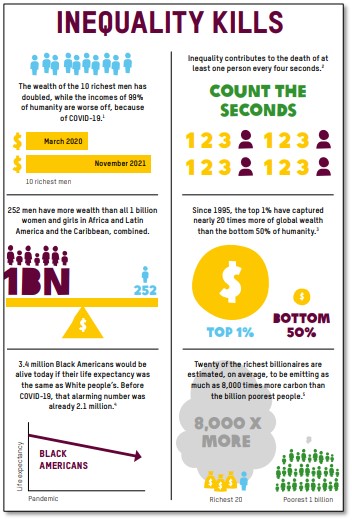
The proposed solutions to the rising Inequalities
- All governments can tax the gains made by the superrich during this pandemic period, in order to claw back these resources and deploy them instead in helping the world.
- Rich countries can channel significant portions of their collective $400bn worth of IMF Special Drawing Rights to vulnerable economies in a way that is debt and conditionality-free.
- Governments can invest in evidence-based and powerful policies to save lives and invest in our future. The legacy of the pandemic must be quality, publicly-funded, and publicly-delivered universal healthcare and universal social protection that offers income security for all.
- Governments can invest in ending gender-based violence through prevention and response programs, ending sexist laws, and financially backing women’s rights organizations.
- Rich governments must fully finance climate adaptation, and back the loss and damage mechanisms necessary to surviving the climate crisis and creating a fossil-free world.
- The single most urgent priority is to end the pandemic, and to do this governments must end the monopolies held over vaccines and technologies through the World Trade Organization (WTO).
- They must insist that these vaccine recipes, and any new vaccines developed in the face of new variants, are an open-source public good, available to be made by every qualified vaccine manufacturer in the world through the World Health Organization.
Sources:
Annual report on Ombudsman scheme
In News
The Reserve Bank of India has recently released its annual Ombudsman report for the nine-month period from July 1, 2020 to March 31, 2021.
About the News
- The report was released in alignment with the change in the Financial Year of the Reserve Bank from ‘July – June’ to ‘April – March' with effect from July 1, 2020.
- RBI has received over 4 lakh ombudsman complaints with most on cards, phone/e-banking.
- According to the findings, Chandigarh got maximum complaints, Kanpur at 2nd spot
What are the important findings of the report?
- On an annualized basis, the volume of complaints received under the Ombudsman Schemes has gone up by 22.27%.
- The overall disposal rate under the three Schemes has also improved to 96.59% as compared to 92.52% in the previous reporting period.
- Integrated Ombudsman Scheme, 2021 integrated the existing three Ombudsman schemes of RBI namely, (i) the Banking Ombudsman Scheme, 2006; (ii) the Ombudsman Scheme for Non-Banking Financial Companies, 2018; and (iii) the Ombudsman Scheme for Digital Transactions, 2019.
- Complaints related to (a) ATM/debit cards and (b) mobile/electronic banking (c) credit cards (d) failure to meet commitments and (e) non-observance of Fair Practices Code (FPC) were the top five grounds of complaints received at the Offices of Banking Ombudsman (OBOs).
- Most of the complaints from customers were related to ATM and debit cards, mobile and online banking, and credit cards.
- A total of 1,85,092 complaints were found to be maintainable under the three Ombudsman Schemes, of which, 67% were resolved through mutual settlement/ agreement.
- The Chandigarh office of Reserve Bank of India (RBI) Ombudsman Scheme received the highest banking-related complaints, followed by Kanpur during the noted period.
- With respect to NBFCs, the major areas of complaints were non-adherence to Fair Practices Code, non-observance to RBI directions and levy of charges without prior notice, accounting for 75.32 per cent of the complaints as compared to 63.23 per cent in the previous year.
- The overall disposal rate improved to 96.59 per cent from 92.52 per cent in the previous year, despite higher volume of complaints.
What are the recommendations by RBI to improve status of ombudsman complaints?
- Enhanced disclosures and intensive review and supervisory actions to make institutions more accountable.
- Formulation of a comprehensive framework for financial education from the perspective of consumer protection.
- Intensified awareness campaigns on consumer protection and the Ombudsman Schemes.
- Taking steps towards inclusion of safe banking practices in educational
- Security measures for electronic transactions – including steps for digital KYC
- Availability of Real Time Gross Settlement System (RTGS) on 24x7 basis.
- Streamlining Quick Response (QR) Code infrastructure, positive pay system for Cheque Truncation System (CTS) to improve online transactions.
- Mandating payment system participants to provide online dispute resolution system for digital payments,
- A comprehensive framework for strengthening of grievance redress mechanism in banks
Sources:
Rooftop Solar in India
In News
India has been lagging behind in achieving its target of 40GW of Roof top Solar (RTS).
About the News
- In 2015, India had pledged to achieve 100GW of solar power by 2022, out of which 40GW was to be from RTS according to its Intended Nationally Determined Contribution (INDC) at Paris in COP 21.
- As of 2021 only 34.6 GW of Solar power has been installed, out which only 1 GW is from RTS (which is only 15% of the targeted 40GW).
- 75% of RTS are installed in Commercial and Industrial buildings.
- Only 23% of the intended subsidies has been utilized on the national average. Even the urbanized centres like Delhi has utilized only 20% of the sanctioned subsidies for installing RTS.
- India has installed only 1.9GW of RTS in 2020-21 which is comparatively low than 9GW of installed capacity in Vietnam.
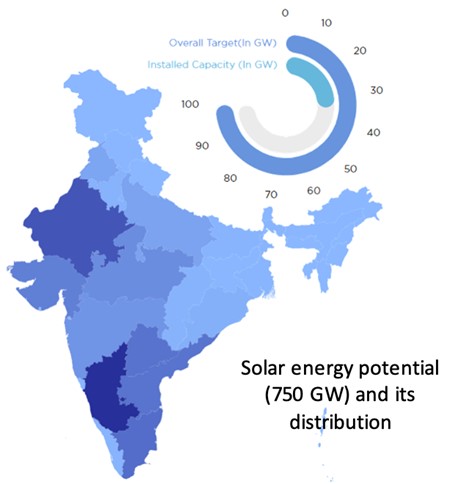
Reason for the Abysmal Performance
- Withdrawal of state level schemes and policies for the RTS and tightening of the regulation by the DISCOMS at times.
- Policy fluctuation regarding Net metering regulation where various ministries and departments do not have concurrence. This has significantly reduced the private investments in the sector.
- One price fits all approach: There is a high price volatility in the real market on one hand, on the other hand there is stagnation of residential RTS price for subsidy calculation of over 18 months.
Suggestions for improving the Performance
- Subsidies to be paid directly to the beneficiaries as done in other schemes (currently, subsidy is paid to the project installer).
- Unrestricted Net metering provision.
- Nudging the public finance institutions for providing the requisite finance.
- Using bank line of credit for RTS sector.
Sources:
X-ray Machine
On January 18, 1896 the X-ray machine was formally displayed by Professor HL Smith, months after German physicist Wilhelm Röntgen invented it in 1895. Wilhelm Roentgen discovered X-rays in 1895—accidentally—while testing whether cathode rays could pass through glass. The first X-ray photograph captured the hand of Röntgen's wife which displayed her bones and wedding ring. Through experimentation, he found that the mysterious light would pass through most substances but leave shadows of solid objects. Because he did not know what the rays were, he called them ‘X,’ meaning ‘unknown,’ rays. Röntgen was awarded the Nobel Prize in 1901 for his invention and contribution in the field of physics. Clinical use of the X-ray flourished, with little regard for potential side effects from radiation exposure. While X-rays remain a cornerstone of modern medicine, their discovery paved the way for the development of today’s broad spectrum of imaging techniques, including magnetic resonance imaging (MRI), computed tomography (CT), ultrasound, echocardiography, and many others -- some of which avoid the use of radiation altogether.
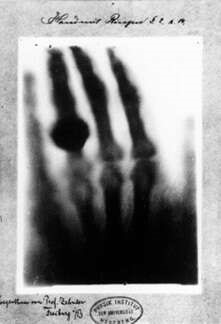
Source:
One Commodity One Exchange
In News
Recently, the Securities and Exchange Board of India (SEBI) issued a consultation paper on “One Commodity One Exchange”.
About the News
- Internationally, derivatives contracts on a specific commodity are traded as liquid contracts (which can be easily traded) only on one particular commodity exchange.
- A derivative is an instrument which derives its value from an underlying asset such as securities and commodities.
- SEBI observed that India should explore developing exchange-specific unique sets of commodities. This will help in reducing the fragmentation of liquidity.
- The concept is not against the concept of universal exchanges and is not being developed to bring any restrictions.

What are commodity derivatives and Commodity Market?
- A commodity derivatives contract is an investment tool that allows investors to profit from commodities without owning them.
- Commodities are the resources or raw materials that are used to manufacture refined goods.
- Under such contracts, commodities such as palm oil, castors seeds, cardamom, black pepper, rubber, etc. are traded. The traders and investors buy and sell these contracts for investing as well as speculative purposes.
- The trading of Commodity happens on certain exchanges, and the aim is to generate profit from the changes in the commodity market through purchase and sale of the commodities.
- India’s commodity exchanges are Multi Commodity Exchange (MCX), Universal Commodity Exchange (UCX), National Spot Exchange Limited (NSEL), etc.
- Currently, of the 91 goods notified for trading by the government, exchanges have launched contracts on 40 such goods. The same contracts are offered by multiple exchanges, which results in liquidity getting fragmented and the exchanges not being incentivised to conduct further research on products that they launched initially for trading.
The Proposed “One Commodity One Exchange (OCOE)” model
- Eligible commodities: The framework may be applicable only for narrow agri-commodities. An agriculture commodity is sensitive if it is prone to frequent government/ external interventions or has seen frequent instances of price manipulation in the past five years of derivatives trading.
- An agricultural commodity is classified as broad if it is not a sensitive commodity and has an average deliverable supply of at least 10 lakh metric tonnes in the past five years with a value of at least Rs. 5,000 crore.
- In case of non-agricultural commodities, the framework should not apply in certain cases including where India: (i) is not a major producer of the commodity, or (ii) is a price taker of international prices.
- Developing commodity contracts: Exchanges may choose to block a commodity with SEBI if it is eligible for development of an exclusive commodity contract (derivative contract).
- After this, exchanges will get a one-month period for detailed research and analysis of the proposed commodity and confirm the block by sharing a feasibility report. If an exchange does not confirm the block within a month, then it will be automatically released.
- Application for product approval is to be submitted within six months of confirming the block. The exchange will have exclusivity status over the commodity for three to five years from the date of SEBI approval.
What can be the Benefits of the OCOE Model?
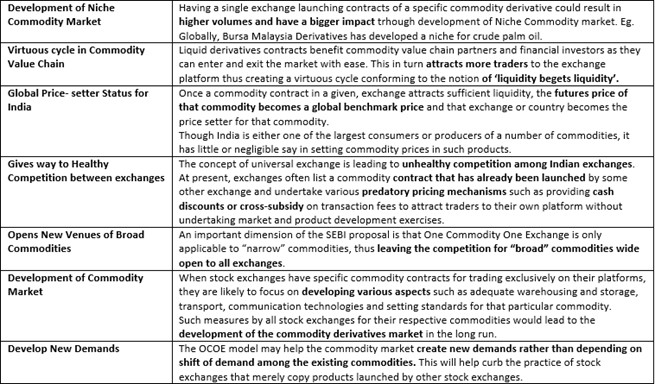
What are the possible risks associated with the model?
- It may create artificial barriers at the cost of other markets and value chain participants, leading to increased overall costs, including trading, compliance and technology.
- Exchanges may block certain products for themselves but subsequently may not meaningfully develop them.
- An exchange, after making efforts for an initial period of 6 months to a year, may lose interest and decide not to invest further in that product and block other exchanges from launching that contract.
- Allowing only one exchange to offer products in a commodity for 3-5 years may go against market development as the designated exchange may fail to build liquidity, but at the same time would continue to enjoy a monopoly status in the said commodity.
- The main rational of having a universal exchange could be lost as participants will have to maintain active trading accounts in each of the stock exchanges in order to trade unique products offered by each exchange.
- No new highly traded liquid commodities have come in to replace traditional liquid commodities in the last so many years. So, this trend may continue in future too and OCOE may fail.
Way Forward
- To address the issue of an Exchange not gaining enough traction, SEBI’s proposal indicates that an exchange has to prepare a commodity checklist, commodity scorecard, finalise a product advisory committee, and product specification before SEBI permits the exclusivity status. The deterrent against an exchange submitting a shallow application, is to bar that exchange from blocking the same commodity for the subsequent year.
- Normally, when contracts on a new commodity are introduced, they attract higher trading volume in the initial months, which may taper off subsequently. To anticipate and prevent further such instances, SEBI should engage with the exchanges and understand why and how they went about choosing a new commodity to list, why some of these new commodities did not garner a single trade, what difficulties the exchanges faced, whether a good faith business attempt was made to develop the market, or if there was any attempt to game the system.
Question: Discuss the One Commodity One Exchange model by SEBI. What can be the possible benefits of this model?
Sources:
Tonga volcanic eruption
This is image of the undersea volcano Hunga-Tonga-Hunga-Ha'apai eruption, triggering tsunami waves in Tonga. Satellite images showed the spectacular eruption, with a plume of ash, steam and gas rising like a mushroom above the blue Pacific waters. Early data suggests it was the biggest eruption since Mount Pinatubo in the Philippines more than 30 years ago. There are some 1,350 potentially active volcanoes around the world. Many are located along a 40,000km (25,000-mile) arc along the Pacific known as the “Ring of Fire”, which is also where about 90 percent of all earthquakes occur.. There are about one million undersea volcanoes – and most are extinct. According to the Global Foundation for Ocean Exploration group, about “three-quarters of all volcanic activity on Earth actually occurs underwater”. During an eruption, hot magma forces the oceanic crust open. This can lead to tsunamis – a series of ocean waves caused by the displacement of water.


Sources:
Doppler Radars
- Context: The India Meteorological Department (IMD) has commissioned four new Doppler radars in Leh, Delhi, Mumbai, and Chennai recently.
- A Doppler radar is a specialized radar that generates velocity data about distant objects using Doppler Effect
- Doppler Effect is the change in frequency of a wave with respect to an observer who is moving relative to the wave source. Example: Change of pitch heard when a vehicle sounding a horn, approaches and recedes from an observer. The frequency increases when the observer and the vehicle are closer and vice versa.
- Doppler radars help forecasters to observe rainfall, the advance of cloud formations over a region and to subsequently monitor thunderstorms and lightning in real-time.
- The radar operations are particularly important during extreme weather events like heavy rainfall, as the data from these are used in predicting flash floods in local regions.
- These radars have been designed and indigenously manufactured by IMD in collaboration with ISRO. With the latest additions, the IMD now has 33 operational radars in the country.
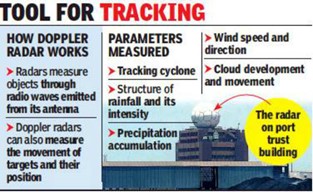
Source:
Open Network for Digital Commerce (ONDC)
- Context: ONDC components, including dynamic pricing is expected to help cut cost of doing business.
- Open Network for Digital Commerce (ONDC) is an initiative of the government to promote open networks for all aspects of the exchange of goods and services over digital or electronic networks.
- The three key components of ONDC that will assist in cutting the cost of doing business include:
- Dynamic pricing
- Inventory management and
- Delivery cost optimization.
- So far only bigger players were able to take advantage of e-commerce while small people were still out of it. However, under ONDC, the protocols would standardize all operations like cataloguing, inventory management, order management etc.
- Through this, small businesses would be able to use any compatible ONDC app instead of being governed by specific platform centric policies.
- The consumers will be able to discover any seller, product or service by using any ONDC compatible application or platform, thus increasing freedom of choice for consumers.
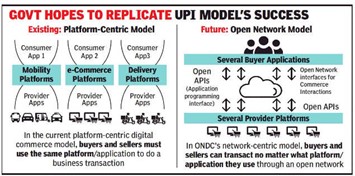
Source:
Mount Victoria Babax
- Context: Mount Victoria Babax bird species has been spotted in India after 25 years.
- The bird was sighted at Phawngpui (Blue Mountain) National Park, located in Lawngtlai district of Mizoram named after Phawngpui, the highest peak in Mizoram.
- Mount Victoria Babax (Pterorhinus woodi) is a bird species that belongs to the family Leiothrichidae.
- It is a streaky brown babbler with a slightly down-curved dark bill and thick black moustache stripe. It can be recognized from persistent inflected bubbling whistles that goes-‘puh-pooo-yih’.
- It is found in a limited geographical range in belt of Eastern Lushai hills of Mizoram and the Chin state of Myanmar and in open forest, forest edges and tangles at elevations of 1200-2800 m.
- The bird is categorised as “Least concerned” in the IUCN Red list.

Source:
Radio collaring of Tigers
- Context: Madhya Pradesh’s famous ‘Collarwali’ tigress who was radio collared, has died at the age of 16.
- The tigress, T15 or Collarwali, of Madhya Pradesh’s Pench Tiger Reserve in Chhindwara district had earned the title of “super mom” as she had given birth to 29 cubs.
- Radio-collaring of animals is a method of studying free-ranging wild animals, tracking their movement and activity patterns via the signals sent to a handheld device or to a computer through a satellite.
- The collar weighs around 1kg and beams signals to a satellite at regular intervals. They have an automatic dropoff mechanism, which will enable field workers to take the gadget off the big cat through remote control.
- They are specially used for secretive species like the tiger or a wide-ranging species like the elephant to prevent the negative interactions between these animals and humans (human-animal conflicts) and to develop strategies to reduce such conflicts.
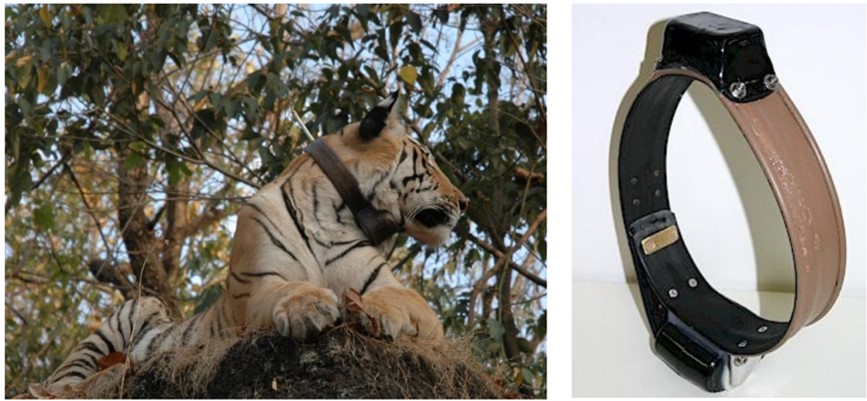
Source:
Just what the doctor ordered for the livestock farmer: TH
Essence: The article highlights that the livestock sector suffers from a major lacuna of absence of veterinary services. Out of the 537 million livestock population, more than 95.8% are concentrated in rural areas .The rural areas lack veterinary services compelling the livestock farmers to travel far, leading to loss in productivity and increased costs. Unavailability of appropriate services often leads to farmers ending up in the hands of quacks or untrained health workers, who happen to prescribe inappropriate antibiotics. This leads to problem of antimicrobial resistance in the animals.
To all these problems, a one stop solution could be Mobile Veterinary Units (MVUs), which will provide doorstep services of diagnosis, treatment and minor surgery. Such services will help in improving the longevity and productivity of the livestock which could in long run provide farmers ease of accessing the credit. Additionally these vans will also generate employment opportunities which is much needed in our country which is recovering from the two waves of pandemic.
Why you should read this article?
- To understand the problems of livestock farmers in rural area.
- To understand the utility Mobile Veterinary Units in solving the Veterinary services problems and role in employment creation.
Source:
Skilling, reskilling, and upskilling to prepare for the future of work: HT
Essence: In current times when India adds approximately 10 million new job seekers every year, the employment gap caused by skill shortage has emerged as a big hurdle in reaping demographic dividend.
To address this, we must focus on increasing the efficiency of skill training systems, ascertaining workforce demands for the coming years and automating heavy duty manual jobs while ensuring that the skill levels of people engaged in these jobs are enhanced.
The author prescribes focus on the human element of the economy by nurturing localized skill sets. A robust and future-ready skill ecosystem is the need of the hour.
Why should you read this?
- To understand core factors responsible for job loss in India
- To understand how skilling ecosystem of India can be reformed to prepare for the future of work
Source:
India Must Give Taiwan A Helping Hand: ToI
Essence: The editorial discusses the theme of Taiwan’s confrontation with the Chinese expansionist agenda and the means Taiwan must apply to withstand annexation attempts. Taipei needs to ramp up its defense and economic preparedness and seek wider international acceptance.
Since Taiwan is the first battlefront for Chinese confrontation, nations like USA, Japan, etc. are assisting Taiwan gain prominence. Due to China’s use of trade as a weapon, only few nations are backing Taiwan, which include Lithuania, Poland, Czech Republic, etc. India must follow suit, to be able to ensure that the story of annexation of Tibet doesn’t get repeated with Taiwan. Diversion of Chinese military towards Taiwan also helps India in withstanding limited Chinese conflicts along Indian borders.
Why you should read this article?
- To understand the multiple ways in which Taiwan needs to be prepared to withstand Chinese invasion.
- To analyze the role of India and impact on India in case Taiwan is annexed.
- To understand the international support being delivered to Taiwan.
Source:
Honour for Exemplary Service
Background:
- Virat, Darmi and Heena were awarded the Chief of the Army Staff Commendation on the eve of Army Day on 15th January 2022.
- Virat is a horse with the President’s Bodyguard (PBG), while Darmi and Heena are Army dogs.

How did these army managed to give exemplary service to Indian Army?
- Virat served as the Commandant's Charger for more over a decade, aweing onlookers with his usual grace and assurance. Despite his advanced age, he showed the potential and disposition to become the most dependable Parade Horse in a short period of time.
- Darmi (Army Dog), in April 2021, took part in a search and rescue operation at a post on the Siachen Glacier. Darmi validated the exact location of damaged, dislocated, and buried Fiber Reinforced Plastic (FRP) that was damaged, dislocated, and buried under 25 feet of hard snow despite the extreme climatic circumstances. Six troops and three porters were rescued as a result of this.
- Heena (Army Dog), a Labrador retriever, is a five-year-old tracker who is "very devoted, even-tempered, clever, highly obedient, and exceptionally reliable," according to the officer in question. Heena was part of a large search operation along the Line of Control in Kashmir in February 2021 after an infiltrator was killed. According to the Army, the excellence of the dogs in use is reflected in the growing demand for them from friendly foreign countries.
- The Exemplary services of the animals in the armed forces displays the strength of the human/animal connection.
Quote: “What count is not necessarily the size of the fighter in the fight- it’s the size of the fight in the fighter”. - Dwight D. Eisenhower
Source:
Share the article
Get Latest Updates on Offers, Event dates, and free Mentorship sessions.

Get in touch with our Expert Academic Counsellors 👋
FAQs
UPSC Daily Current Affairs focuses on learning current events on a daily basis. An aspirant needs to study regular and updated information about current events, news, and relevant topics that are important for UPSC aspirants. It covers national and international affairs, government policies, socio-economic issues, science and technology advancements, and more.
UPSC Daily Current Affairs provides aspirants with a concise and comprehensive overview of the latest happenings and developments across various fields. It helps aspirants stay updated with current affairs and provides them with valuable insights and analysis, which are essential for answering questions in the UPSC examinations. It enhances their knowledge, analytical skills, and ability to connect current affairs with the UPSC syllabus.
UPSC Daily Current Affairs covers a wide range of topics, including politics, economics, science and technology, environment, social issues, governance, international relations, and more. It offers news summaries, in-depth analyses, editorials, opinion pieces, and relevant study materials. It also provides practice questions and quizzes to help aspirants test their understanding of current affairs.
Edukemy's UPSC Daily Current Affairs can be accessed through:
- UPSC Daily Current Affairs can be accessed through Current Affairs tab at the top of the Main Page of Edukemy.
- Edukemy Mobile app: The Daily Current Affairs can also be access through Edukemy Mobile App.
- Social media: Follow Edukemy’s official social media accounts or pages that provide UPSC Daily Current Affairs updates, including Facebook, Twitter, or Telegram channels.

